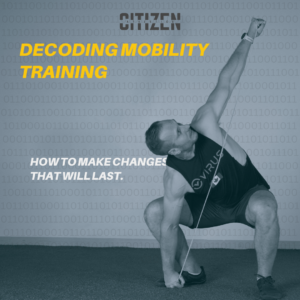How would you feel if we told you that you’d have ‘perfect mobility’ when you woke up tomorrow? What would that look like for you?
An ass to grass squat? A seamless overhead position? Maybe you just want to not feel so stiff every time you sit on the can! The reality is, we all envision ‘mobility’ a little differently.
So, why is there so much external pressure for us to all gain mobility ‘the same way?’ We’ve heard it all before:
‘Hold X stretch for 45 seconds, mobilize in Y direction, then foam roll Z muscle for 30 seconds…’
The lists of routines and sequences are endless.
If you’re anything like us, you’re getting stretched, pulled and mobilized in every direction possible on ‘the best way’ to gain mobility. Unfortunately, finding the ‘best way’ to gain mobility is about as likely as finding the ‘best way’ to cook a steak, or the ‘perfect’ exercise routine; it just doesn’t exist.
At Citizen Athletics, we’re not trying to sell you on a ‘method’ of mobility, or some course that promises to make you a ‘range of motion guru’. Hell, if all you want is a smattering of free mobility exercises, just click below.

Instead, we’re trying to provide a nuanced and well-thought guide that allows you to train the way you want, while continuing to improve the positions that you encounter in your daily life.
Are you ready? Let’s dive in!
WHAT IS MOBILITY?
Just like any other regiment designed to improve strength, endurance or size, a truly effective mobility program is going to take time and consistent effort to truly maximize its overall benefit. Sure, camping out on a foam roller for 30-60s once a week can leave you with some transient relief and freedom of motion, but this ‘freedom’ only lasts so long. How do we make changes that will last?
Well, our first step is understanding how we actually gain more mobility.
Alright, hold on tight Citizen team, I’m going to get all ‘sciencey’ on you for a second, but I swear it’s worth it!
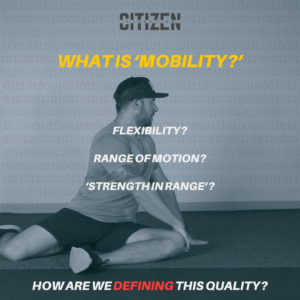
Mobility is something that is described as a ‘task-dependent’ quality. This means that mobility is gained based on the activities that you do the most! Have you ever seen a competitive Olympic Weightlifter squat? What about a professional basketball player? Now, who do you think does the most squatting? Yeah, enough said…
Ahh yes, the classic ‘Jordan v. Lebron’ debate. While there are clear differences in body size and lever length that make Jordan Delacruz a more proficient ‘squatter’ than Lebron James, there is also a large discrepancy in squatting practice and overall time spent in the squat that makes Jordan more equipped to tolerate fast, deep ranges of squatting.

‘Task Dependent’ means that you will improve your mobility when you appropriately manage your training. Crazy right? You actually become more mobile simply by changing the repetitions, intensity, and frequency of the exercises that you want to improve. Almost seems too good to be true, right? So why aren’t you seeing mobility gains from session to session, despite ‘practicing’ all the time?
Think about improving mobility through similar means as improving strength. Meaningful gains will take a long time to improve, and they’re largely going to depend on how often you train for those gains. If you’re quarter-squatting low volume reps 2-3 times per month, I think it’s pretty safe to say there’s an obvious reason why you’re not improving your mobility, and it has nothing to do with your 10 step warm up routine.
Stop for a second. If you’re interpreting this as: ‘Just do the thing you want to get better at, and the mobility will come,’ you’re on the right track. BUT, there’s more to it than just squatting, pressing, or hinging more. ‘Doing the thing’ is definitely one way to improve your mobility, but many can take this thought process and run with it a bit too far. Let’s try to stay more diplomatic and see what others have to say.
THE ‘WINDOW OF OPPORTUNITY’ DEBATE:
“But, what if we could maximize the temporary effects from stretching, rolling, or mobilizing while also appropriately managing the difficulty, frequency and repetitions of exercises that we’re performing?!”
This is a common stance, and one that generally, I tend to side with, but as always, there’s a catch.
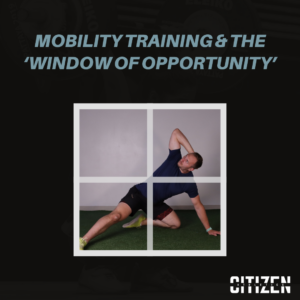
As logical as it may seem, there is quite a bit of controversy around this type of strategy. Some argue that using any ‘passive’ implement whatsoever (ie foam roller, massage gun, activation drills, etc.) is a ‘slippery slope’ and will lead to excessive time wasted on activities that are unlikely to move the needle from a performance perspective. While I agree that those interventions aren’t going to make you the next Michael Jordan (or Jordan Delacruz, for that matter), I don’t think that this slope is as ‘slippery’ as it’s been made out to seem.
Often, these arguments involve the notion that individuals are spending 30+ minutes on activation drills before any type of lift is performed. I’m not sure about you, but in the 10+ years that I’ve been lifting, and 8 years that I’ve been coaching, I don’t think I’ve ever seen or worked with someone who spent that much time on a gym-based warm up… ever.
The financial term ‘opportunity cost’ is often brought up in the performance and rehab worlds, referencing that the time you spend doing something is also time you could have spent doing something else. And while humans are bound by time constraints, knowledge and experience to make meaningful decisions, we can still reasonably disperse our time spent on an intervention without immediately losing all of our gains from a session.
If there is a reasonable conclusion as to why you’re performing 1-2 sets of a stretch, or low-level drill before (or in between) your warm up sets of an exercise, then have at it. Hell, you probably would have spent that time scrolling on your phone regardless! How’s that for ‘Opportunity Cost?’
The reality is, adding a quick stretch or sitting on a foam roller as a form of mobility in-between your warm up sets is perfectly fine. Will it optimize your performance, make you feel better than ever, and add millions to your bank account? Unlikely. But it probably won’t hinder your performance meaningfully either, so we’ll leave it at this:
If you want to do it, go for it. If you don’t, then don’t!
PUTTING THE PIECES TOGETHER
When I think about ‘mobility work,’ I think about devoting intentional energy towards a position or task. A random smattering of mobility drills from the internet just doesn’t do it for me. Instead, I tend to follow the KISS method during my warm ups. So pucker up and lean in, it’s about to get weird.
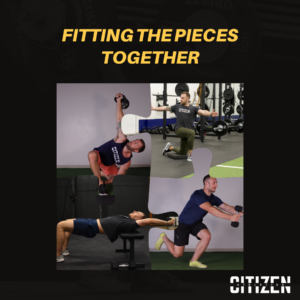
If you want to warm up for your next squat day, you should probably start by testing out how a bodyweight or empty bar squat feels. (*Spoiler alert* – It’s going to feel like sh%t.)
Now, BEFORE you run to your beloved band, foam roller, or massage gun… you’ve got 2 options. Behind Door 1, you just try doing more repetitions of the movement and see if it feels better. This will take care of most peoples’ perceived restrictions faster than they’d like to admit. Behind Door 2, you could find some type of monostructural warm up routine (ie – rower, bike, treadmill, etc.) and see if elevating your body temperature is effective for changing mobility (spoiler alert #2 – it is).
How does it feel after your 10th air squat? What about 20th? What about 30th? Okay… now we’re just doing cardio at this point. Take a break.
Does it feel any better? If yes, KEEP GOING! You may not need to waste 5-15 minutes of your precious gym time with stretches and rollers; you may be able to warm up by… dare I say… managing your load effectively?! (*gasps*).
But, what if you still have those lingering nags, pinches, or grabs? No worries! Now’s the time that you can use your favorite mobility implement in between sets to eek out those last degrees of motion, or calm that nagging pinch. Spoiler alert #3 – just pick one, they all do the same thing (yes, even the ones that vibrate). A little rolling or stretching here and there, and voila! You’re ready to start crushing your top sets of squats, presses and any other exercise with ease!
Now for the nuance – ‘more is not better.’ If you’re reading this thinking ‘well my squats feel fine right now, but I bet they’ll feel even better after foam rolling.’ Let me be the first to stop you there. If you’re able to do the task without pain or marked limitations, then don’t go chasing optimal. Just get back under that bar and keep greasing the groove! THAT is where the ‘opportunity cost’ debate comes into play. Remember, if mobility is a ‘task specific’ quality, then we want to spend as much time improving our ability to perform the task itself (ie – keep doing the thing) before letting our wandering eyes take us to the next implement promising the fountain of youth.
If you’re looking to learn more about mobility, OR find different strategies on how to make lasting changes to your core lifts, click here to download our FREE Top 30 Mobility Exercises! You might be surprised with what you find.
AND if you’re struggling with managing your own programming, or want more ‘deep dive’ content like this, the Citizen Athletics app is the perfect entry point into science-backed training from trusted Physical Therapists & Coaches with years of education & experience in the field; all at your fingertips.
Click here to get started today!
ABOUT THE AUTHOR:
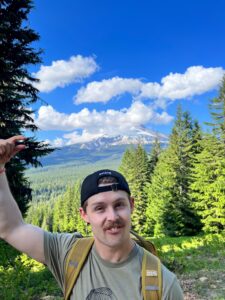
Dylan Carmody is a Doctor of Physical Therapy, and Strength & Conditioning Coach with 5+ years in the performance and rehab industries.
Having dabbled in training modalities like Olympic Lifting, Cycling, Powerlifting, and CrossFit, Dylan has a deep appreciationfor all things performance, while still having a positive and fun-loving approach to exercise.
Dylan’s coaching experience is equally eclectic, ranging from performance coaching for elite athletes in the NCAA D1 setting, to group fitness and weight loss coaching in his early career.
With detailed exercise programming & consistent communication, he aims to create a training environment that is not only ‘tolerable’ for clients’ aches and pains, but truly helps to resolve their issues in the first place.


